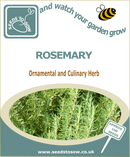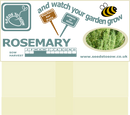Description
Rosemary, a hardy perennial, can be used for ornamental, culinary and medicinal purposes. It's dark foliage are like soft pine needles with an aromatic scent and flavour. Rosemary can be grown as a clipped hedge, pruned and shaped as topiaries or simply grown as a culinary herb in a pot or container on a patio.
| When to Sow | Sow indoors March to May. |
| Where to Sow | Grows best in light well drained soil, in a sunny position. |
| Sow seed on the surface of lightly firmed, barely moist seed compost in pots or trays. | |
| Cover with a sprinkle of finely sieved compost as they need light to germinate and maintain at a temperature of 18 to 24°C (65 to 75°F). | |
| What to do Next | When seedlings are large enough to handle, transplant into 7.5cm (3in) pots and harden off the plants for 7 to 10 days. |
| Plant them outside in their final growing position once the risk of frost has passed, 38cm (15in) apart. | |
| Whilst the plant is still young keep the compost moist however once established, since rosemary is a drought resistant plant, do not overwater. | |
| When transplanted, pinch out the tip of each stem to encourage the plants to bush outwards. | |
| Harvest | All year round once established. |
| Handy Tips | Rosemary seeds can be slow to germinate, therefore ensure they are kept under ideal conditions. |
| Don’t over-harvest the plant in the first year to allow the rosemary time to become established. | |
| Companion Planting | Cabbage and Carrots as Rosemary repels cabbage white butterfly and carrot fly. |
| Nutritional Information | Rosemary is a good source of Vitamin A, Vitamin C, Vitamin B6, Folate, Calcium, Iron, Manganese, Magnesium and Dietary Fibre. |
| Serving Suggestion | Rosemary is an excellent herb to flavour soups, stews, fish or meat dishes. It goes well with roasted meats, especially lamb, pork, chicken and is a great addition to roast potatoes. |
Payment & Security
Your payment information is processed securely. We do not store credit card details nor have access to your credit card information.




